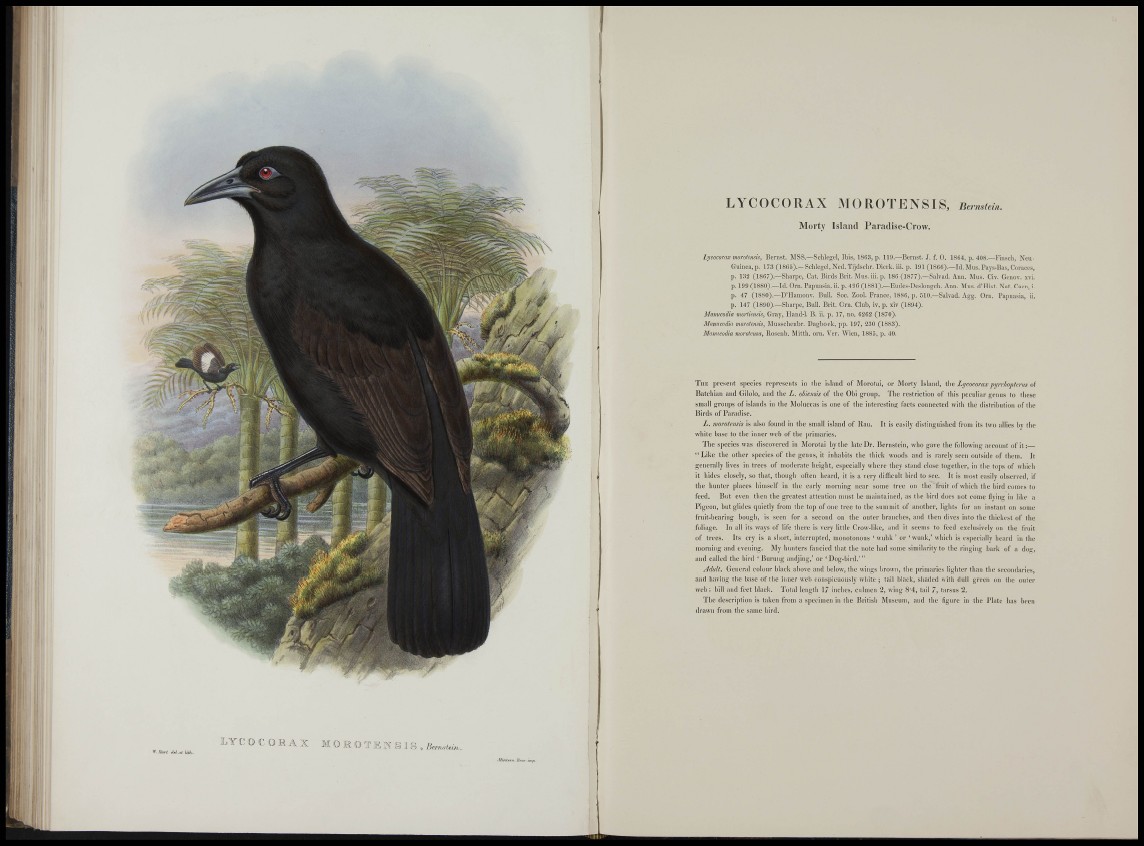
p i
1
l ' I
4
11 1
îiÎ
K il
i l
»'.»art M.,I lull.
: O M O T E N S I S , .
• Vin/^lll. Ill-o.'. itfif,.
LYCOCORAX MOROTENSIS, Bernstein.
Morty Island Paradise-Crow.
Lycocm-ax morotcnsis, Bernst. MSS.—Schlegel, Ibis, 18fi3, p. 11!).—Bei-nst. J. f. 0 . 1804, p. 408.—Finsch, Neu-
Guinea, p. 173 (1865).—Schlegel, Ned. Tijclschr. Dierk. iii. p. li)l (ISCC).—Id. Mus. Pays-Bas, Coraces,
p. I.'i2 (1867).—Sharpe, Cat. Birds Brit. Mus. iii. p. 186 (1877).—Salvad. Ann. Mus. Civ. Gcnov. xvi.
p. 109 (1880) .—Id. Orn. Papuasia, ii. p. 4B0 (1881).—Eudes-Deslongch. Ann. Mus. d'Hist. Nat . Caen, i.
p. 47 (1880).—D'Hamcnv. Bull. Soc. Zool. France, 1886, p. 510.—Salvad. Agg. Orn. Papuasia, ii.
p. 147 (1890).—Sharpe, Bull. Brit. Orn. Club, iv. p. xiv (1894).
Mmmcodia mortiensis. Gray, Hand-1. B. ii. p. 17, no. 6202 (1870).
Mamiccdia moroiensis, Musschenbr. Dagboek, jip. 197, 230 (1883).
Mamicodia morotema, Rosenb. Mitth. orn. Ver. Wien, 1885, p. 40.
T H E present s|)ecies rejiresents In llic island of Morotai, or Morty Island, Lycoco7'aa^ pyrrhoptcnis oi
Batcliian and Gilolo, and the L, olticnsis of the Obi group. The rcstrietion of this peeuliar fienus to these
small groups of islands in the Moluccas is one of the interesting facts connected with the distribution of the
l i i r d s of Paradise.
L. morotcnsis is also found in the small island of Kan. It is easily distinguished from its two allies by the
white base to the inner web of the primaries.
The species was discovered in Morolai by the late Dr . Bernstein, who gave the following account of i t : —
" L i k e the other species of the genus, it inhabits the lliick woods and is rarely seen outside of them. It
generally lives in trees of moderate height, especially where they stand close together, in tlie tops of vvhicli
it hides closely, so that, though often heard, it is a very difficult bird to see. It is most easily observed, if
t h e hunter places himself in the early mornii}g near some tree on the fruit of which the bird eornes to
feed. But even then the greatest attention must be maintained, as the bird docs not eome flying in like a
Pigeon, but glides quietly from the top of one tree to the summit of another, lights for an instant on some
f r u i t - b e a r i n g bough, is seen for a second on the outer branches, and then dives into the thickest of the
foliage. In all its ways of life there is very little Crow-like, and it seems to feed e,\clusively on the fruit
of trees. Its cry is a sliort, hiterrn])ted, monotonous ' wuhU ' or ' wuni;,' which is especially heard in the
morning and evening. My hunters fancied that the note had some similarity to the ringing bark of a dog,
and callcd the bird ' Burung andjing,' or * D o g - b i r d . ' "
Adult, General colour black above and below, the wings brown, the ])rimaries lighter than the secondaries,
and having the base of the inner ^veb conspicuously white ; tail black, shaded nith dull green on the outer
web; bill and feet black. Total length 17 inches, eiilmen 2, wing 8'4, tail 7, tarsus 2.
T h e description is taken from a specimen ii] the British Mnseum, and the figure in the Plate has been
drawn from the same bird.